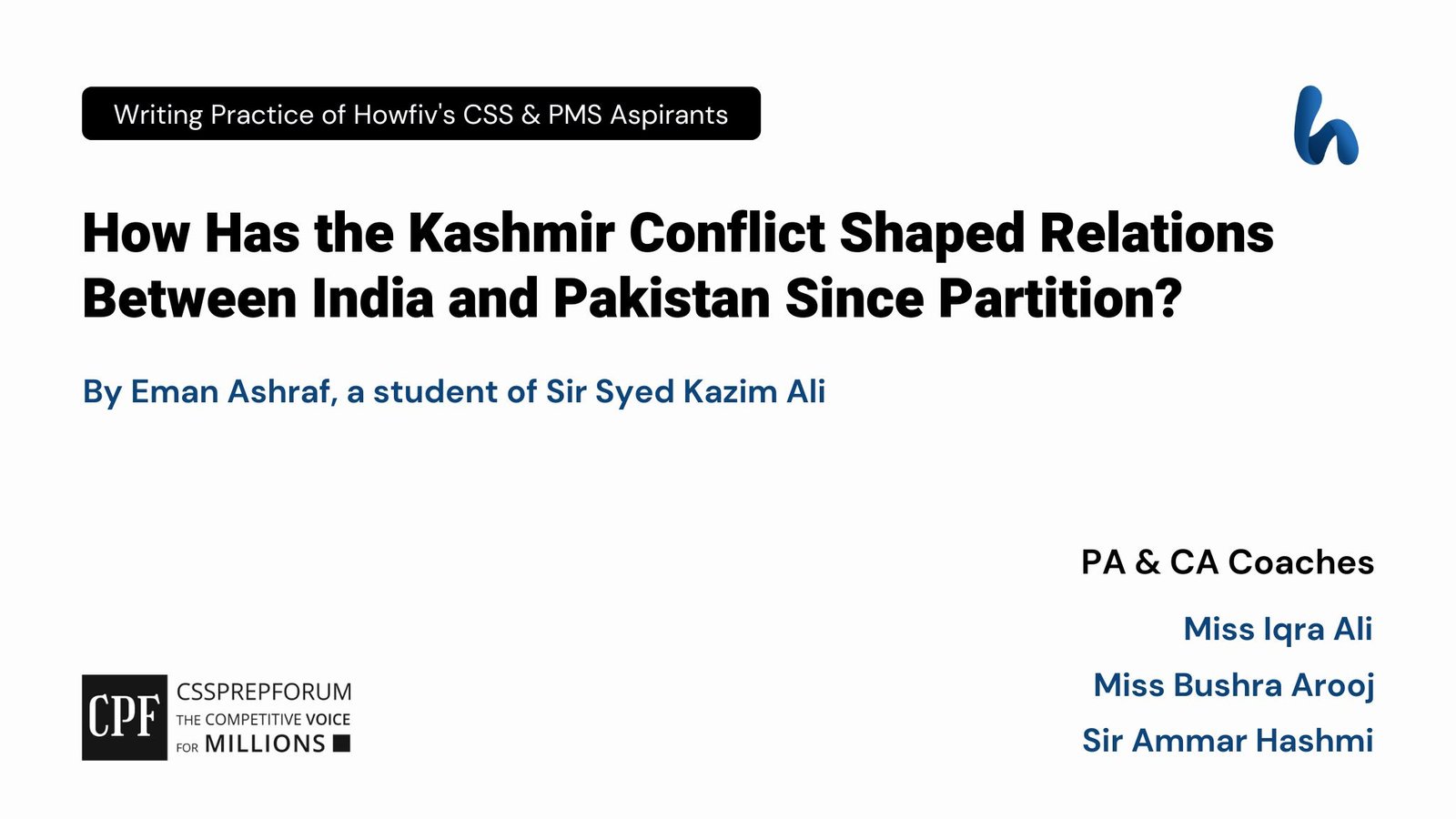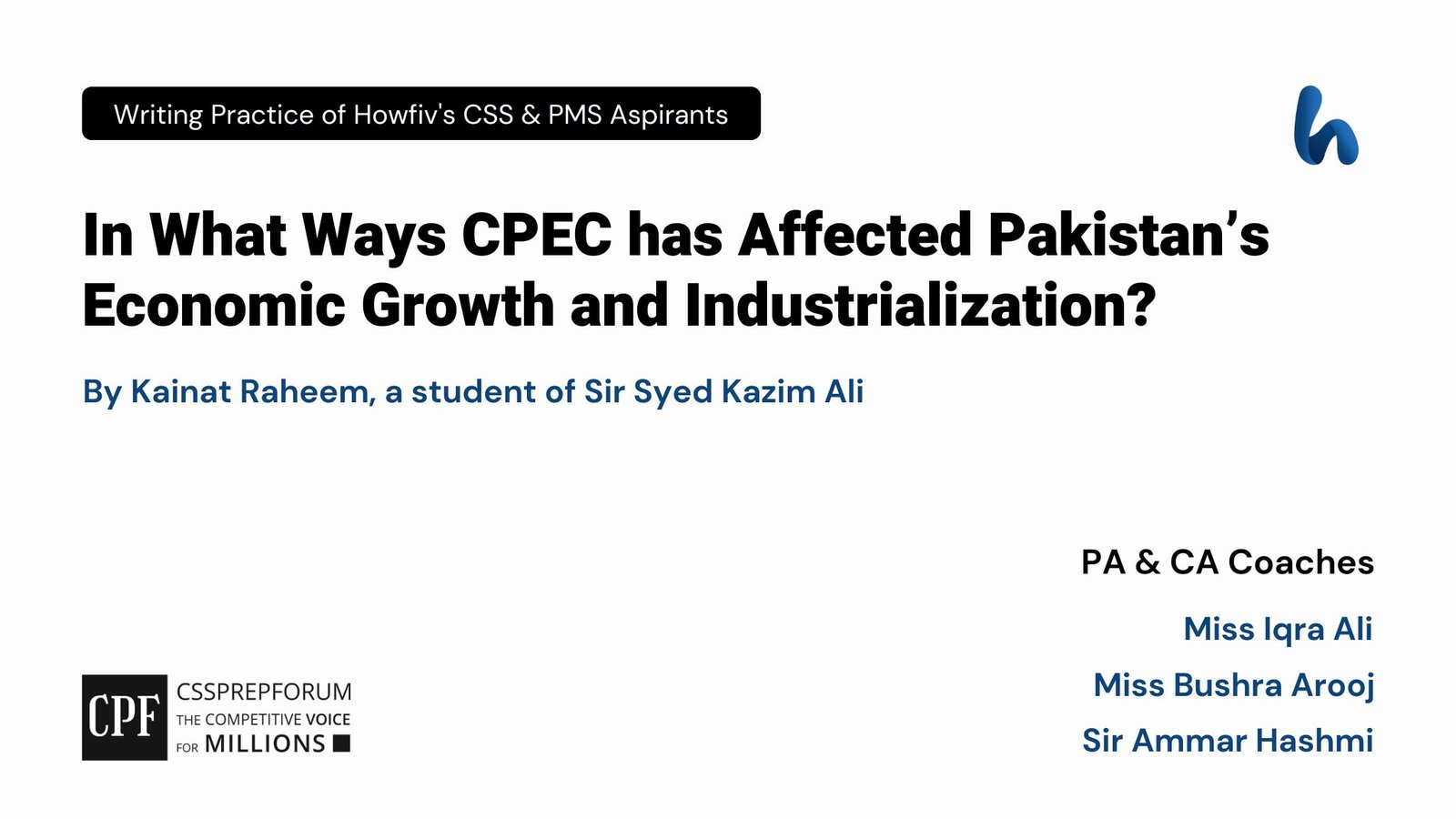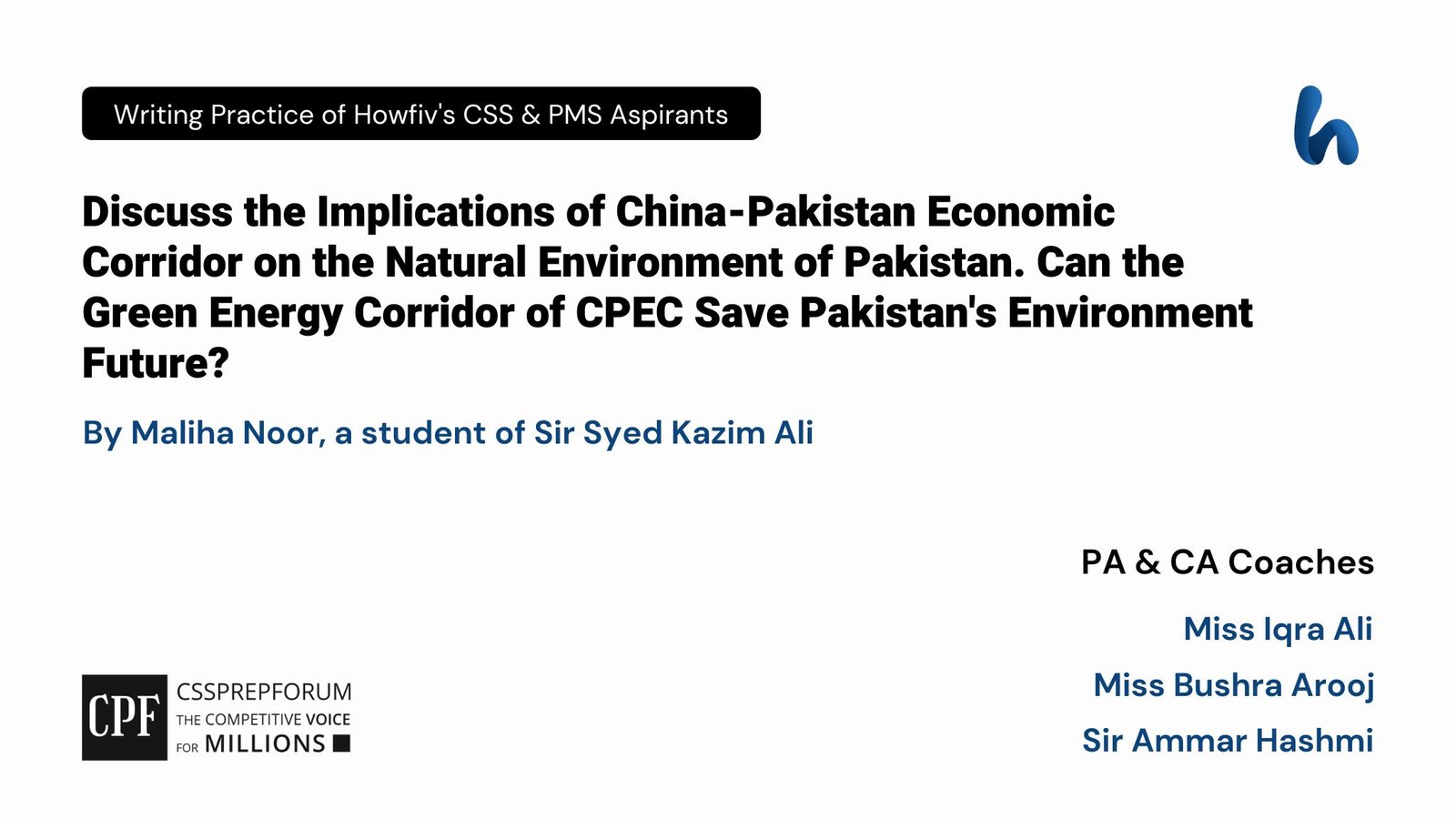CSS Solved Gender Studies 2022 Past Paper | Discuss in detail the feminist movements in Pakistan
The following question of Gender Studies is solved by Ateeqa Atia Ul Musawar , the highest scorer in CSS Gender Studies. Moreover, the question is attempted on the same pattern, taught by Sir to his students, scoring the highest marks in compulsory subjects for years. This solved past paper question is uploaded to help aspirants understand how to crack a topic or question, how to write relevantly, what coherence is, and how to include and connect ideas, opinions, and suggestions to score the maximum.

Question Breakdown
The focus of this particular article is on the feminist movements within the context of Pakistan. The central theme of this article would be that, basically, what are the catalytic factors that contributed towards the initiation of feminist movements in Pakistan? Besides, under this question, a reader gets to learn about the steps that have been taken by the executive bodies and the governmental institutions to introduce equality for women in Pakistan. In addition, this article will unwrap the arguments hidden beneath the shades of criticism of the current situation, as well as the gap between theory and practise in feminist scholarship and the real lacunas to endorse equality.
Outline
1-Introductory Remarks
- ✓The plight of women is not a novel phenomenon,
- ✓Feminism is considered a myth and anti-Islamic
- ✓Equality for women is a taboo in Pakistan
- ✓Women- the second-class citizen
- ✓Half of the population is facing suppression at the hands of their counterparts
- ✓Women-friendly measures by different governmental regimes
2-Understanding the timeline of feminist movements
- ✓Pre-partition age
- ✓Post-partition scenario
- ✓ Glimpse the era of field Marshall Ayub Khan
- ✓ Contributory efforts under Zulfikar Ali Bhutto’s era
- ✓Zia-ul Haq’s period- the triggering one
- ✓ Benazir Bhutto’s regime –the cornerstone to women’s rights
- ✓ General Pervez Musharraf – an era of modernism as Kemalists principle
- ✓ Zardari Era- A period of collaborative efforts to trigger the feminist movement
3- Critical Appraisal
4- Conclusive Remarks

Answer to the Question
“No nation can rise to the height of glory unless your women are side by side with you; we are victims of evil customs. It is a crime against humanity that our women are shut up within the four walls of the houses as prisoners. There is no sanction anywhere for the deplorable condition in which our women have to live“
-Quaid e Azam Muhammad Ali Jinnah
Introductory Remarks
Women’s plight is not a new phenomenon in any part of the world, whether in the west or the east. Owing to this, women have always come to the forefront to fight against the suppression of women. Pakistan also does not lag in paving the way towards women’s equality. Since its inception in 1947, Pakistan has been fighting against the exploitative and subjugating treatment of women under the influence of patriarchy. Like in other countries around the world, the backlash against socioeconomic and political inequality has sparked feminist movements in Pakistan too. Feminist movements have always been active, sparked by issues such as domestic violence, acid attacks, violations of freedom, educational rights, and many others. The predicament of women’s oppression is a continuous phenomenon that has made women second-class citizens. Undoubtedly, different governmental bodies under different executives have advocated for the equality of women and taken several initiatives to foster the spirit of equality. Not only feminists, but several prominent non-governmental organizations (NGOs) also played a key role in granting women the status that Islam granted them centuries ago. Seeing through the lens of feminism. The despotic fact, as seen through the lens of feminism, is that women have internalized their sufferings and turned a blind eye to the suppression caused by various social and economic factors. cant contribute in areas such as access to education, labour rights, and political representation. However, the fight for full gender equality is still a pipe dream. Talking about equality rights is still taboo in Pakistan, even in the 21st century, as a result of which the status quo of patriarchy is still dominant, and feminism is a myth and anti-Islamic in Pakistan.
Understanding the timeline of the feminist movement
Feminism in Pakistan has a complex history divided into a number of periods. Before partition, the debate on feminism began in the 1930s and 1940s. The struggle for political, social, and educational rights started even in the colonial period. With the passage of time, feminist movements with different spirits emerged in different regimes.
- ✓ Pre-Partition age:
Advocacy for women’s rights began even during the colonial period, when British laws were unfavorable to women’s rights. The Muslim personal law passed in 1937 helped women achieve their rights. Sir Syed Ahmed and other proponents played a crucial role in granting the rights to women.
- Anjuman e Hamayat Islam opened schools for girls in 1885
- Women’s education training school was opened in Calcutta in 1889
- Sir Muhammad Shafi and his daughter Jahan Ara opened the first organization for women
- Anjuman-e-Khwateen -e-Islam opened for women in Lahore in 1908.
- Girls hostel by Begum of Bhopal was opened in 1915 in Aligarh
- Women also joined the All-India Muslim League in 1915
- Memorandum of equality represented by Begum Jahan Ara in round table conferences (1930) demanding rights for all without discrimination on the basis of caste, color, or creed.
- Six million women were liberated under the government of India Act 1935 to make it possible for them to participate in the council of state and provincial assemblies
- Fatima Jinnah led millions of women to fight for their rights.
“No nation can be worthy of its existence that cannot take its women along with men. No struggle can ever succeed without women participating side by side with men.”
–Fatima Jinnah
- ✓ Post-Partition Scenario:
The desire to achieve the status granted to women by Islam motivated women to keep feminist movements alive even after partition. As a result of their efforts, a number of initiatives to ensure women’s socioeconomic and political rights were launched in newly-born Pakistan.
- All Pakistan Women’s Association (APWA) was founded by Begum Ra’ana Liaquat Ali Khan in 1949
- In 1951, Agricultural rights were granted to women for which they were fighting since 1948
- United front was established under the stewardship of Begum Jahan Ara, which proved the mouthpiece piece for women in 1955
- Chief justice of Pakistan made it possible to legally recognize the right of marriage and divorce
- Constitution of 1956 granted rights to women
- Women Action Forum (WMA) was established in 1981, the purpose of which was to disclose the conspiracies against women’s rights.
- ✓ Glimpse the era of Field Marshall Ayub Khan (1958–1968)
In the era of Ayub Khan, the Muslim Family Laws Ordinance (MFLO) was passed in 1961. This particular ordinance gave rights with regard to marital life, divorce, and the custody of children. This act was passed owing to the particular efforts of the All Pakistan Women’s Association. (APWA). In addition, Fatima Jinnah campaigned for feminist causes in the 1965 presidential elections against military dictator Ayub.
- ✓ Contributory efforts under Zulfikar Ali Bhutto’s era (1972–77)
In Zulfiqar Ali Bhutto’s era, the 1973 Constitution proved to be the cornerstone for providing rights to women. A number of articles in the 1973 constitution privileged women by granting them rights without any discrimination on the basis of caste, color, or creed.
Article 25
1- All citizens are equal before the law and are entitled to equal protection of the law.
2- There will be no discrimination on the basis of caste, color, or creed other than on the basis of sex. Besides this, other special provisions under Article 25 provide protection to women and children.
Article 27
It stated that there would be no discrimination based on gender, caste, or religion in appointments to the Pakistani military.
Article 32
It is of the Basic Principles of State Policy guaranteed the reservation of seats for women,
Article 35
This Article stipulates that the state shall protect marriage, family, and mother and child.
Besides, the Pakistan People’s Party established a woman‘s wing under the stewardship of Nusrat Bhutto. Under this, 5% of seats were introduced for women in the provincial assembly and 10% in the national assembly.
- ✓ Zia ul Haq’s period, the triggering one: (1977-1988)
The Zia ul Haq era was essentially the catalyst for the women’s movement to take off. The law that sparked the women’s movement at the time was an offence under Zina. The enforcement of the Hadood Ordinance (1979) by Zia ul Haq gave power to Pakistan’s feminist movements. This ordinance empowered women to become feminist activists. Basically, the Zina Ordinance conflated rape with adultery. That Hadood Ordinance asked the victim to present four witnesses before the court for the claim to be accepted by women. This ordinance has erased the basic difference between the two and made it impossible for women to prove rape. Not only this, but the victim’s failure to prove the adultery made her the culprit. That ordinance made the actual rapist go scot-free instead of being behind bars.
Regime’s harsh Punishments
Zia ul Haq introduced the harshest punishments under the context of Islamization.
- ✓He introduced punishments such as flogging, executions, torture, and execution and sentencing by military courts
- ✓Initiated controversial execution of the Hudood Ordinance
- ✓Banned women from participating in sports and from being audiences of sports
- ✓Promoted purdah
- ✓Suspended all constitutional rights, including the right to freedom, on the basis of no discrimination.
Reactive behaviour against the aura of Islamization
The terrific reaction against the Islamization principles of Zia came initially in the form of the Women Action Forum. In 1981, a group of women gathered in Shirkat Gah, Karachi to open the debate on the covert conspiracy by Zia-ul-Haq. Women Action Forum became an inspiration to
Initiatives by Woman Action Forum
Woman’s Action Forum contested a huge number of protests in the 1980’s period against the implementation of the law of evidence. That association also played a pivotal role in exposing the misinterpretation of Islam under the pseudo-scholar and its cursory role in the modern world Furthermore, that association added more to the contributory efforts by making ways possible for women to play an active role in the sociopolitical domains. With the passage of time, Women Action Forum became the mouthpiece of the wave of feminism emerging in Pakistan Dupatta jalao movement (1982) was launched in Lahore against the remonstrations of Zia Ul Haq It was filed under the Zina ordinance and it encouraged women to safeguard and preserve the few rights that have been given to them Adding more to the triggering factors, Pakistan Women Lawyers marched with the collaboration of Women Action Forum towards High Court. The purpose was to abolish the law of evidence. The then government tried to overcome protest through different restraining acts such as using tear gas and filing charges against the feminist groups. The wave did not restrict to Lahore only but took other major cities of Pakistan into the whirlpool of the feminist wave trigger feminist movements in Pakistan
Case in point
1- Fahmida and Allah Baksh case (1982)
In this case Allah Baksh had married Fahmida against the wishes of her family and he was punished with 100 lashes on the charge of adultery.
Proponents
The writings of prominent feminist activists proved to be the cornerstone for granting women’s rights. Kishwar Naheed’s Hum Gunahgar Aurtain (We sinful women) and Fahmida Raiz’s Chaadar or Chardiwari (“the veil and four walls”) mushroomed the growth of the movements in Pakistan. These writings and poems became the anthem of the feminist movement all around Pakistan. Not only that, but numerous organizations, through their contributions, made the road to equality smooth. Among them, the Aurat Foundation, Rozan, and Bedari were the most significant
- ✓ Benazir Era-Corner Stone to Women’s Rights
Women-friendly policies were implemented during Bhutto’s two tenures and remarkable periods (1988-1990 and 1993-1996). These include
- Establishing women’s studies centres
- Initiation of separate public universities for women
- Setting up the first women’s bank
- Establishing a separate police station for women
- Representation by Benazir Bhutto at the Fourth World Conference on Women in Beijing (China)
- Pakistan became a signatory to the Convention on the Elimination of All Forms of Discrimination Against Women (CEDAW).
- ✓ Musharraf Era: an era of modernism as a Kemalists principle (1999-2007)
A number of initiatives took place during the Musharraf regime. Musharraf, a supporter of Mustafa Kamal Ataturk, and his modernist ideology fueled the flames of equality. There were major factors in Musharraf’s regime that truly granted women’s rights.
- 33% historic representation of women
- 17% of seats are reserved for women in both provincial and national assemblies.
- Shamshad Akhtar was appointed as the first female governor of the State Bank.
- Establishing the National Commission on the Status of Women (2000) as a statutory body
- Gender Reform Action Plan (GRAP) to make it obligatory for governments to ensure gender inequality.
- Enactment of the Women’s Protection Bill (2006)
- Repealed some of the Hadood Ordinance
- Rape was taken out of the Hadd (maximum) penalty and added to Pakistan’s Criminal Procedure Code.
- The confusion between rape and adultery was cleared up.
- The rape case was treated in the same manner in other countries.
- Except for terrorism and murder, approximately 1300 women were released in 2006.
- In 2006, the Cabinet approved a 10% quota for women in the central superior services.
- Besides it, women cadets from the military academy (Kakul) assumed charge as guards at Mazar-e-Jinnah.
- ✓ Zardari Period: A period of collaborative efforts to trigger the feminist movement (2008-2013)
The governmental period of Zardari gave impetus to the spirit of feminism while also displaying the plight of women. It is the Zardari era, in which 12-year-old Malala Yousaf was shot for her outstanding contributions to women’s rights. It was during this period that Chand Bibi, a seventeen-year-old girl, was publicly flogged by the Taliban for having an illicit relationship with a neighbour. Further, Zardari’s regime contributed by passing the number legislation. It introduced
- Law Against Acid Attacks
- Protection of women from sexual harassment in the workplace
- Sharmeen Obaid Chinoy’s documentary on acid attacks gave impetus to legislation against acid attacks.
- Obaid’s A Girl in the River documentary on the surging issue of Honour killing helped to overcome the lacunae in the Honour killing laws.
- Fehmida Mirza was appointed as the first female speaker of the national assembly in South Asia.
- Hina Rabbani Khar was appointed as the first female foreign minister.
- One of the political parties, the Mutahida Quami Movement Party, holds the world’s largest women’s rally.
- The law of inheritance was passed in 2011.
- A domestic violence bill was implemented in 2012.
- The Ministry of Women’s Development was established at the federal level.
- The Sexual Harassment Act (2010) was passed.
Critical appraisal and conclusive remarks:
Since the birth of Pakistan, feminism has been a widely contested and contentious subject in the history of that country. Myopic-versioned people often label it as western propaganda and an anti-Islamic approach. Despite this bone of contention, a number of organizations and proponents have come forward to stand against the suppression of women. These feminists and organizations work under the umbrella of feminist movements to achieve socioeconomic and political rights. The core purpose of the feminist movement is to address the issues faced by women, and owing to this, the movement has gained momentum. The startling slogans of equality and patriarchy have made it possible for women to commence debate upon the number of factors that are impeding the development and growth of women. The strong stance of feminism has made it possible to raise voices against the menace of exploitation by creating an atmosphere of Aurat March. Not only this, but International Women’s Day is celebrated to make the roots of feminism strong. Despite all these crucial initiatives, there is still a question mark regarding the treatment of women. Is Obaid’s Saving Face and A Girl in the River documentaries enough to make equality possible? Can the equality of women be guaranteed by passing a stock of legislation? The answer is a big no. To summarize, despite the passage of legislation, the contributions of non-governmental organizations, and feminist marches, gender equality remains a major myth and taboo in Pakistan till the pseudo implementation of legislative measures.

CSS Solved Past Papers’ Essays
Looking for the last ten years of CSS and PMS Solved Essays and want to know how Sir Kazim’s students write and score the highest marks in the essays’ papers? Then, click on the CSS Solved Essays to start reading them.
CSS Solved Essays

CSS Solved General Science & Ability Past Papers
Want to read the last ten years’ General Science & Ability Solved Past Papers to learn how to attempt them and to score high? Let’s click on the link below to read them all freely. All past papers have been solved by Miss Iqra Ali & Dr Nishat Baloch, Pakistan’s top CSS GSA coach having the highest score of their students.
General Science & Ability Solved Past Papers
CSS Solved Pakistan Affairs Past Papers
Want to read CSS Pakistan Affairs Solved Past Papers and learn how to attempt them to score high? Let’s click on the link below to read them all freely. All past papers’ questions have been attempted by Sir Kazim’s students, who scored the highest in the subject.
CSS Solved Pakistan Affairs
CSS Solved International Relations’ Past Papers
Have you opted for International Relations in the CSS examination and want to score above 150? Then, click on the CSS Solved International Relations’ Past Papers by Miss Abeera Fatima, the top IR scorer and the best IR coach in Pakistan.
CSS Solved International Relations Past Papers
Articles Might Interest You!
The following are some of the most important articles for CSS and PMS aspirants. Click on any to start reading.












